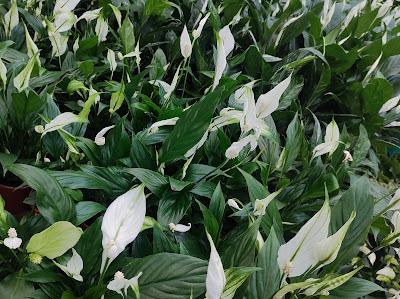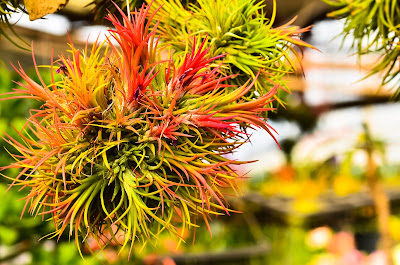The Best Air Purifying Plants for Indoors According to a Botanist
Are you curious about the most effective air purifying
plants to have inside your home? I am. My parent and grandparents always had
live plants in their homes and I just thought they liked tending to the plants.
Now that I am older, I realize there was a method to the madness! So, I did
some research and this is what I found.
If your indoor air smells musty, or if you experience respiratory
distress when opening windows then it is likely time for a change in your
housekeeping strategies. Today, let's discover which houseplants are ideal for
providing effective odor control and freshening up those stale odors!
1. Bamboo
Bamboo is undeniably one of the most sought-after indoor
plants. Not only does it provide an excellent deal of comfort with its leafy
stems and pleasing variegation, but it also enhances the ambiance of any space.
Also, unlike some other houseplants that can become a bit of an eyesore when
grown too large - this species remains slender even when grown to fruiting
sizes!
This versatile plant has an immense range of uses, from
being used as a decorative element in rooms of all types – including offices
and spas alike – to even providing oxygenation during the process of pruning.
For those who labor under fluorescent lighting, adding a few bamboo standees
around their workplace could be just what they need!
2. Peace Lilies (Spathiphyllum)
Peace lilies are among the most popular indoor
houseplants, owing to their innocuous design and tranquil expression. This
particular species boasts some potent properties that make it an ideal choice
for purifying the air:
Peace lilies can help reduce airborne particulate
matter, volatile organic compounds (VOCs) and pollen from your space. This is
achieved through rapid growth, intense foliage coloration and abundant blooms!
3. Golden Pothos
Hailing from the tropics, this cheerful plant is an
ideal choice for adding a splash of color to any space. Its shiny leaves can be
utilized in arrangements or simply admired as they bask in their own beauty!
The golden pothos thrives in moderate light and can be
sustained indoors if necessary. In fact, it's actually quite hardy and a
suitable addition to apartments and more spacious abodes alike!
4. Maranta Diversa
If you're searching for a plant that can purify the air,
then look no further than the Maranta diversa. This tender plant thrives in
U.S. Department of Agriculture plant hardiness zones 10-11 and features leaves
which are speckled with lemon yellow on their undersides.
The Maranta's origins lie in the United States - this is
rooted in its ability to survive temperatures as low as -5°C or 23°F. Even at
these frigid conditions, it remains fully erect!
Its extraordinary cold tolerance means that this member
of the genus Marantaceae creates an unfriendly environment for airborne
pathogens, such as airborne molds or fungi.
5. Bamboo-like Air Plants (Eucomis)
Are you searching for a convenient solution for
purifying air in your home? Look no further than Eucomis - an eco-friendly
plant that's ideal for purifying indoor air. By utilizing this evergreen
succulent as part of a plan to create a more comfortable atmosphere, you could
be on the cusp of creating an ideal haven within your abode!
Eucomis are among the most adaptable plants available,
boasting a lifespan of more than twenty years under optimal conditions.
6. Senecio Vulgaris
The genus Senecio is packed with an abundance of air-cleansing plants, and no species stands out more than the common vulgaris variety. This diminutive plant boasts robust leaves that are pungent when crushed but are remarkably effective at removing pollutants from indoor air; it even serves as a natural green remedy for bronchitis! This plant's purifying properties make it an ideal addition to any home office or study.
7. Hedera Helix (English Ivy)
Hedera helix, commonly known as English ivy, is a
perennial flowering plant that thrives in temperate zones. This species has
attained cult-like status within modern botanical circles as well as among
interior designers seeking to incorporate its graceful appearance into their
spaces - be it for aesthetic purposes or for health reasons!
To safeguard against indoor air pollution and other
hazardous particulates, the most effective plants are those with high
concentrations of volatile organic compounds (VOCs) such as Hedera helix. This
hardy evergreen can thrive in even the most unforgiving environments thanks to
its ability to adapt readily and flourish under extreme durations of sunlight
exposure; making it ideal for use in greenhouses and at home alike.
8. Spider Plants (Chlorophytum)
A multitude of species have been identified within this family, and they come in a plethora of shapes and sizes. Grown like annuals, their leaves can vary between oblong to lance-shaped; however some varieties boast heart-shaped foliage! Some even possess variegated patterns that create a captivating display for onlookers alike!
Though boasting impressive structural prowess, these
plants are adept at removing small particles from the air around them -
including pollen and dust mites! Their foliage is particularly effective at
trapping these airborne irritants, making it an ideal option for those who
suffer from allergies or asthma.
9. Miniature Jade Plant (Crassula Minima)
Not only is the Jade Plant a captivating specimen for
its attractive foliage, but it also possesses an abundance of antioxidants and
anti-inflammatory properties; making it an ideal choice if you're looking for a
plant that may help alleviate symptoms from acute inflammation.
Just like all succulents, the miniature variety is
highly resilient. Unlike other plants which require high humidity levels to
thrive properly, Jade plants require less moisture than most potted specimens -
proudly displaying up to five-feet tall in favorable climates!
10. Air Plant
An
air plant is a type of tropical plant that doesn't need soil to grow. Instead,
they absorb moisture and nutrients from the air around them. They are also
known as Tillandsia and are native to Central and South America. Air plants are easy to care for and don't require much maintenance. All they need is bright, indirect sunlight, regular misting or soaking in water, and occasional fertilizing. They can be placed in terrariums or hung on walls with nails or string.
Air plants make great houseplants because they don't take up much space and bring an interesting touch of nature into your home. These houseplants absorb airborne pollutants without sacrificing their sleek appearance; they remain green while absorbing harmful particulates! are an ideal choice for anyone seeking an atmospheric focal point, as well as those seeking to reduce the levels of formaldehyde in their environment. With proper care, these unique plants will thrive for years to come!
Although they may lack any capacity to remove gasses, air plants can still do a fantastic job of purifying the air in your abode. Their terracotta hues and wispy foliage make them hard to spot amidst other decor – so when you place these unusual decorations around, it's easy to forget about them until it's time for them to be refreshed with new potting soil!
Conclusion
If you're seeking a cost-effective solution for
improving indoor air quality, consider investing in a purifying plant. Don't be
deceived by their diminutive size - these plants can make a big difference! Try
placing one or more of our selections in your home today for an elevated level
of wellness.
Hope you found this article helpful. Thank you for reading it.
👉This post may contain affiliate links. As an Amazon Associate and member of other affiliate programs, we earn from qualifying purchases.
About the Author
Meet Britney! She's a dynamic entrepreneur with a zest for life. Britney's love for animals shines through in everything she does. She enjoys vacationing at the beach, where she finds peace and relaxation. A Halloween enthusiast, Britney brings a touch of spooky fun to her creative endeavors. Her passion for fitness and wellness drives her to explore new ways to stay healthy and active. Britney’s diverse interests make her contributions to our blog both inspiring and enjoyable.













Comments
Post a Comment